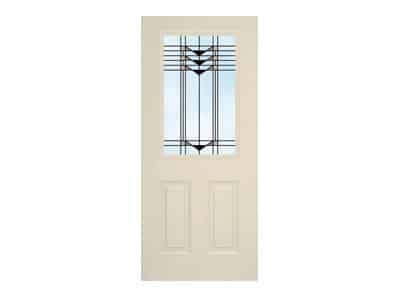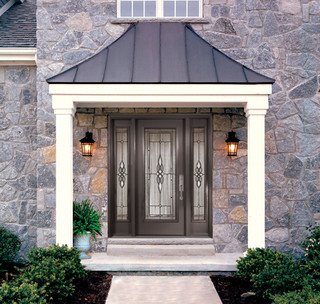Your home’s entry doors are a crucial part of your home’s building envelope. When it comes to thinking about energy efficiency and keeping your home warm in the winter and cool in the summer, what you’re really thinking about is your home’s building envelope. So before I get into whether or not you should consider a storm door, let’s first make sure we understand the role an entry door and a storm door play in protecting your home.
A building envelope separates your home’s interior from outside and protects it from weather and energy loss.
A closed entry door forms a crucial part of your home’s building envelope. When an entry door is open, it’s creating a gap in your home’s building envelope. If your door is closed but not sealed properly, it lets energy escape like leaving the door partially open.
So when it comes to thinking about storm doors, you really want to consider two things:
- Is your existing entry door already energy efficient?
- Does harsh weather expose your entry door?
Is your entry door already energy efficient?
When I talk to homeowners about their entry doors and windows with respect to their building envelope, the most crucial concepts I discuss are
– proper insulation
– adequate ventilation
– sufficient sealing
When it comes to entry doors, good weather stripping and a tight seal are the first things to consider about an entry door’s energy efficiency.
If your current entry door is newer and made of fiberglass…

Then check its weather stripping and caulking. If your door has cracks or feels drafty, fix these issues before installing a storm door. Weather stripping and sealing will insulate your door and block drafts around the frame. These drafts can be one of the top drivers of high-energy bills.
If you have an old, wooden door…
A storm door can help conserve energy. If your older house’s entry door has a window and lacks modern upgrades like thermal glass and sealants, installing a storm door will reduce heat loss. New, energy-efficient glass shields your home better than an old wooden door with nicks and cracks that let energy escape. Drafts coming through gaps around your entry door frame usually indicate an older, warped door that needs replacement. An old warped door no longer has a tight seal, and this seal is</strong> really what you want for your home’s building envelope.
Is your entry door exposed to the weather?
If you don’t have an overhang or roof above your entry door, a storm door will provide protection against snow, sleet, and driving rains. If your door is exposed to weather, it will take a beating unless protected by a storm door. and you have a porch or overhang at least four by four feet, your door is well shielded, so a storm door may not be needed.
So are storm doors necessary?
An entry door seals tightly, fits well, and resists weather, you might not need a storm door. If you’re unsure about how well your entry door is performing check out these entry door warning signs!
If you’re a fan of vintage charm, you’ll adore the endless creative ways to repurpose an old door.




